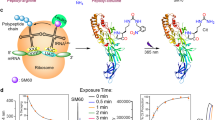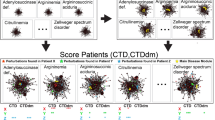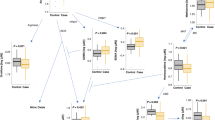Abstract
Extract: A case is described of an infant with a deficiency of liver argininosuccinate synthetase, characterized by rapidly increasing drowsiness, respiratory insufficiency, and convulsions starting 67 hr after birth, which resulted in the death of the patient on the 4th day.
Quantitative analyses of amino acids in blood plasma showed increased concentrations of citrulline (2.64 mM) lysine (1.25 mM), histidine (0.34 mM), glutamine (4.17 mM), proline (1.67 mM), glycine (1.35 mM), alanine (3.96 mM), and methionine (0.24 mM).
The activity of argininosuccinate synthetase in a liver biopsy was found to be below the limits of detection, whereas the activities of carbamylphosphate synthetase and ornithine transcarbamylase (21.8 and 55.6 μmol/min × g wet wt, respectively) I were higher than those of the control tissue.
The activity of arginase (141.1 μmol/min × g wet wt), an enzyme localized behind the enzymic block, was found to be lower than that of the controls (230–800 μmol/min × g wet wt).
It is suggested that these differences are due to adaptation of urea cycle enzymes to protein intake as demonstrated by Nuzum and Snodgrass [14] in primates.
The activity of argininosuccinate synthetase of a postmortem brain biopsy was found to be normal. This points to a different genetic origin (isoenzyme) of the brain enzyme.
Cultured amniotic cells of a fetus from a pregnancy in the same family, taken in the 20th week of pregnancy, demonstrated incorporation of ureido-14C-citrulline into trichloroacetic acid (TCA)-soluble material to an extent half of that observed with cultured amniotic cells from a normal fetus (31 dpm/μg DNA and 68 dpm/μg DNA, respectively). This has been interpreted as being due to the heterozygotic state of the fetus.
After a normal pregnancy a healthy boy was born.
Speculation: The metabolic basis for neurologic abnormalities in citrullinemia is not known. In the present case a virtual absence of argininosuccinate synthetase of liver was found, whereas the activity of the brain enzyme was normal. As the blood ammonia concentration was never found to be abnormal, it is postulated that citrulline itself is toxic, i.e., inhibitory to a biochemical reaction.
Similar content being viewed by others
Log in or create a free account to read this content
Gain free access to this article, as well as selected content from this journal and more on nature.com
or
Author information
Authors and Affiliations
Rights and permissions
About this article
Cite this article
Roerdink, F., Gouw, W., Okken, A. et al. Citrullinemia, Report of a Case, with Studies on Antenatal Diagnosis. Pediatr Res 7, 863–869 (1973). https://doi.org/10.1203/00006450-197311000-00001
Issue date:
DOI: https://doi.org/10.1203/00006450-197311000-00001
Keywords
This article is cited by
-
Neuropathology of citrullinaemia
Acta Neuropathologica (1982)
-
Ultrastructural pathology in congenital defects of the urea cycle: Ornithine transcarbamylase and carbamylphosphate synthetase deficiency
Virchows Archiv A Pathological Anatomy and Histology (1981)
-
Complementation analysis in fibroblasts from eight patients with clinically different forms of citrullinaemia
Journal of Inherited Metabolic Disease (1981)
-
Citrullinaemia: The possibility of prenatal diagnosis
Journal of Inherited Metabolic Disease (1980)
-
Citrullinemia
Virchows Archiv A Pathological Anatomy and Histology (1978)



